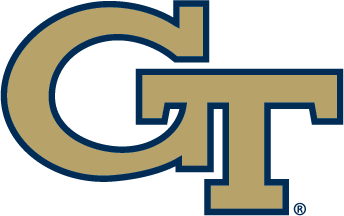Sept. 27, 2007
By Jack Wilkinson –
On a Saturday of disappointment in Charlottesville, something good came of Georgia Tech’s loss at Virginia. Something very good and, thankfully, blessed.
Correy Earls is OK. He can move. Move everything, even if his neck’s still stiff and sore.
“It answered a prayer,” head coach Chan Gailey said.
A collective prayer, one all the Jackets, the Cavaliers and a Scott Stadium crowd of 57,681 began to pray in concert. With just under five minutes left in Tech’s 28-23 loss, Earls went down and didn’t get up. Didn’t move a muscle at first. The redshirt freshman wide receiver from Macon had abandoned his post pattern and come back to block once he saw quarterback Taylor Bennett scrambling on third down.
Bennett came up inches shy of a first down. Earls didn’t come up. Not for what seemed an eternity. At first, Clay Farr hadn’t noticed. The Tech assistant team trainer was busy attending to yet another injured player on the sideline.
“I just heard the crowd go kind of silent,” Farr said. “Any time you hear no noise or a big noise, you pop your head up.”
Farr saw Earls laying on the ground, on his back, motionless. Everyone did.
“It was very frightening,” said fullback Mike Cox. “I was on the sidelines. It was right in front of me.” Cox recalled seeing Earls “out of the corner of my eye” as the play unfolded. Later, after seeing a replay, Cox recalled what happened:
“Correy came back to block and seal the edge on a big defensive lineman. He was a lot smaller, and they hit and he kind of fell and went limp. It was a nightmare. My teammates are my brothers.”
They all quickly converged on Earls: Farr. Jay Shoop, Tech’s director of sports medicine and head trainer. Dr. John Xerogeanes, the team physician. Equipment manager Tom Conner. Up in the pressbox, sports information director Dean Buchan was thinking “how eerily quiet that stadium was. There were nearly 60,000 people there, and it was completely quiet.”
“When a guy goes down for awhile like that,” Gailey said, “it’s very frightening. You’re much more like a parent than a coach.”
Charles Earls, Correy’s father, was in the stands, watching. He’d driven all night to see his son play, leaving Atlanta at midnight, eating breakfast in Charlottesville, then catching the noon kickoff. Now, the oldest of his five children, who’d already caught two passes that afternoon, lay perfectly still. Charles Earls came down on the field.
“I heard Doctor X (Xerogeanes) asking Correy to try to move his leg,” Farr recalled. “That’s the first time it hit me, that it could be something to do with his spine.”
Like almost everyone, Farr thought of Kevin Everett, the Buffalo Bills tight end who was severely injured in an opening-day, head-to-head collision two weeks earlier. Initially, doctors feared Everett was paralyzed and would never walk again. His prognosis has improved significantly, thanks, largely, to state-of-the-art treatment in which Everett’s spinal cord was chilled.
At the time, however, Earls “had very little leg movement,” recalled Farr, who said he’d only experienced one similar situation during a practice several years ago. For Correy Earls, this was a new and terrifying experience.
“Very, very scary,” he said. “I remember making contact with the guy, and then everything just went black, until I saw everyone standing over me.”
Earls thinks he was unconscious for a second or so. “My eyes were closed,” he said. “When I came to and heard voices, they were trying to get my eyes opened, but I couldn’t see their faces. I couldn’t feel anything. I actually wanted to get up and continue playing. But when I tried to move, nothing moved. It was like I’d lost touch.”
He, too, thought of Kevin Everett. “With what happened to the guy a few weeks ago,” Earls said, “it hit me that I might not be able to play, might not be able to help my team.” Might not be able to walk, either. Or even move.
“Yeah,” Earls said, “that was another thing.” It’s a thought that crosses every football player’s mind at some time or another. “You hope it doesn’t happen,” Earls said, “but you don’t take it to the field. You just play your best, play aggressively, and leave it in God’s hands.”
On the field in Charlottesville, though, there was grave concern. “We saw enough to be concerned that we needed to get him to the hospital and have some tests done,” Farr said. “At first, Correy said his body was numb.”
“It was like more of a tingling feeling all over my body,” Earls said.
On the field, after Earls was examined, he had to be gently placed on a spine board and carefully, but firmly, secured. Farr also had to remove the facemask from Earls’ helmet, so a blue strap could be wrapped around the player’s helmet and head, shoulders and body to immobilize him.
Farr always carries a tool specifically designed to remove facemasks. “I have it in my pouch for games, practices,” he said. “We practice with it each year, show people how to cut off facemasks.” This, however, was the first time he’d ever had to use it in a game, and in such a delicate, precarious situation. Farr was prepared, one of many things that went right on this day.
“Not that it’s a good thing, but Virginia had a defensive back, Lyles, number 30, who had a similar incident [last time Tech played in Charlottesville in 2005],” Farr said. “His was a little more serious. A disc issue. But they had a plan in place because of that.”
While Earls lay still on the field, Nate Lyles stood nearby beside a kneeling teammate and watched. And Lyles understood, as no one else could understand in that moment.
Earls was driven in an ambulance to the nearby University of Virginia Medical Center. There, Farr said, he underwent X-rays, an MRI and CT scans. “To make sure there was no disc problems, cervical or spinal,” Farr said. “As those tests came back, we got a better understanding that things looked good. Within three or four hours, Correy’s movement and strength had improved considerably.”
Initially, Earls was examined, tested and treated in a room in the hospital’s trauma center. “At one time,” Farr remembered, “I counted 22 people – doctors, nurses, interns, orthopedic residents.” Charles Earls was there, too. He was understandably upset, and very concerned. “He had a right to be,” Farr said.
But as tests were performed and Correy responded, those initial, terrible fears began to fade. “Correy really wasn’t himself again until about 10:30 that night,” Farr said. By then, Charles had begun to reassure his wife, Cherrie, who was constantly, frantically phoning. She wanted to drive up to Charlottesville. Charles told her to stay with relatives in Atlanta. Correy spoke to his mother, too, to ease her mind.
By Saturday night, Farr said, “I had text messages from almost all the players.” From several coaches, too: Gailey, receivers coach Buddy Geis and Giff Smith, who’d recruited Earls. And from the training staff. Farr had good news: Earls was OK. By midnight that evening, Charles Earls could finally get some sleep, as his son slept in a regular room on the hospital’s neurology floor.
Farr stayed in Charlottesville, too, and had already made alternate travel plans for Sunday’s trip home. “I decided not to mess with planes,” he said. Instead, Farr rented a mini-van from the airport and removed the middle seats, “in case he wanted to stretch out.” By Sunday morning, Correy was still in a neck brace, still very sore. But, Farr said, “He was smiling, eating food and moving.”
A visitor dropped by: Virginia coach Al Groh, who wanted to check on Earls and share the story about Nate Lyles’ injury last season. “And that he’d come back and played well the previous day,” Farr said.
“He was telling me that things were going to be OK,” Earls said. “If I needed anything, to let him know. They’d been through the same situation. And even though they were the opponent, he was very sympathetic and comforting.”
Later Sunday morning, Correy Earls walked slowly, but surely, out of the hospital and got into the van. He slept on the drive home. “It’s when I had to play catch-up on sleep,” he said Tuesday, smiling slightly after eating lunch. “You don’t really get any sleep in the hospital, with the nurses and doctors checking on you every hour.”
Once back in Atlanta, he embraced his mother. He met several teammates back at the Edge Athletic Center. Earls returned to his dorm with his roommates, Demaryius Thomas and Robert Hall. Earls returned to class; he hopes to be back on the field soon.
“Not any more than two, three weeks,” he said. As for his neck, “There’s a little pain, tenderness, soreness. Nothing too bad, nothing too serious. They just want to make sure everything heals and I’m 100 percent.”
And when he does return, what will he have taken from this experience? “Just play hard,” Correy Earls said. “You never know when your last game is going to be. So take advantage of your opportunities.”









